Lowell is a historic Massachusetts city located on the Merrimack River in Middlesex county about 30 miles north of Boston.
Incorporated in the 19th century, Lowell was a mill town named after businessman Francis Cabot Lowell, inventor of a manufacturing system known as the Lowell System.

Before it became a mill town, Lowell was home to Pawtucket and Pennacook Indians for thousands of years but their population was significantly reduced by an epidemic around 1619.
The following is the history of Lowell, Massachusetts:
1605:
- On June 17, French explorer Sieur De Mont discovers the Merrimack River.
1617-1619:
- An epidemic significantly reduces the local Pawtucket and Pennacook population in the area.
1643:
- The Massachusetts General Legislature establishes the county of Middlesex.
1647:
- Reverend John Eliot makes a series of missionary visits to the Native-American villages at Pawtucket Falls and Wamesit Falls.
1652:
- Captain Simon Willard and Captain Edward Johnson visits the area and decides to create a settlement there.
1655:
- On May 29, the Massachusetts General Court incorporates the town of Chelmsford and the town of Billerica.
- To prevent the local natives from being displaced, Colonial authorities establish the Wamesit reserve, a tract of land, between the Merrimack and Concord rivers, for use by the Pennacook tribe.
1656:
- The Massachusetts General Court modifies and enlarges the boundaries of Chelmsford and the Wamesit Indian Reservation.
1660:
- The Massachusetts General Court modifies and enlarges the boundaries of Chelmsford and the Wamesit Indian Reservation for a second time.
1665:
- A ditch is dug to clearly mark the boundaries between the town of Chelmsford and the Wamesit Indian Reservation.
1669:
- Wannalancet, sachem of the Penacook Indians of Concord, NH, fears an impending attack by the Mohawk tribe so the Penacook rows down the Merrimack River to Wamesit and builds a fortified fort on the hill at Belvidere, now called Fort Hill. The white settlers shut themselves up in their garrison houses in anticipation of this suspected Mohawk attack.
1726:
- The village of Wamesit, which later became the center of Lowell, was annexed to Chelmsford.
1792:
- The Pawtucket Canal is constructed.
- A bridge is constructed at Pawtucket Falls.
1796:
- The Pawtucket Canal opens in East Chelmsford.
1803:
- The Middlesex Canal opens near Lowell.
1813:
- Phineas Whiting & Josiah Fletcher open a cotton mill on the Pawtucket Canal.
- Francis Cabot Lowell and associates establish the Boston Manufacturing Company.
1814:
- Francis Cabot Lowell establishes the first mill in Massachusetts in nearby Waltham.
1817:
- On August 10, Francis Cabot Lowell dies and Nathan Appleton and Patrick Jackson become the leaders of the company.
1821:
- The Boston Manufacturing Company decides to open another mill and choose Pawtucket Falls in Lowell as the location.

- On December 1, Appleton, Jackson, and several others establish the Merrimack Manufacturing Company.
- Thomas Hurd builds a new mill at Lower Locks that uses power looms.
1823:
- Merrimack Mills becomes the first major textile mill in East Chelmsford.
1824:
- St. Anne’s church is established.
- The first newspaper, the Lowell Daily Journal, is issued in Lowell.
- The Merrimack Manufacturing Company builds a school on Merrimack Street in East Chelmsford.
1825:
- The Merrimack Company’s Machine Shop is completed.
- The Hamilton Manufacturing Company is incorporated.
- The Middlesex Mechanics Association is incorporated.
1826:
- On March 1, the village of Wamesit in Chelmsford is incorporated as a town and it is named in honor of Francis Cabot Lowell.
- The population of Lowell at the time is 2,500.
1827:
- The first Universalist Church is established in Lowell.
1828:
- The Lowell Manufacturing Company is incorporated.
- Appleton Manufacturing Company is incorporated.
- The Lowell Bank is incorporated.
1829:
- The Lowell Institute for Savings is founded.
1830:
- The Boston and Lowell Railroad is incorporated.
- The Lowell fire department is established.
- The Middlesex, Tremont, and Suffolk Manufacturing Companies are established.
- The population of Lowell is 6,477.
1831:
- The Lowell high school opens.
- Battle of the Stone Bridge takes place.
- The Lawrence Manufacturing Company is established in Lowell.
- The Railroad Bank is incorporated.
1832:
- The Lowell Bleachery is incorporated.
1833:
- The Lowell Irish Benevolant Society is founded.
- The Police Court is established.
- A poor farm is established in Lowell.
- On June 26, President Andrew Jackson and Vice President Martin Van Buren visit Lowell.
- On October 25, Henry Clay visits Lowell.
1834:
- On July 11, artist James Abbott McNeill Whistler is born in Lowell.
- The Lowell Mill Girls strike.
- The Belvidere Manufacturing Company is established.
- David Crockett, George Thompson, Michel Chevalier, and Daniel Webster visit Lowell.
1835:
- Lowell was connected with Boston, Nashua, Groton, and Lawrence by the Boston and Lowell Railroad.
- The Boot Cotton Mills is incorporated.
- The Tri-Weekly Courier is published.
1836:
- On April 1, Lowell becomes the third incorporated city in Massachusetts.
- The Lowell Mill Girls go on strike for a second time.
- The Lowell dispensary is founded.
- The population of Lowell is 17,663.
1837:
- The Market House is built on Market Street.
1839:
- The Massachusetts Mills are incorporated.
- The Whitney Mills are incorporated.
- On April 17, Mayor Luther Lawrence killed by falling into the Middlesex Mills wheel pit while showing visitors around his mill.
- John Street Congregational Church is established.
1840:
- The Lowell Corporation Hospital opens.
- The Lowell Museum is founded by dry goods merchant Moses P. Kimball.
- The population of Lowell is 20,981.
1841:
- The Lowell cemetery is established on Knapp Ave.
- The Vox Populi newspaper is established.
- Louis Bergeron and his family become the first recorded French-Canadian family to settle in Lowell.
1842:
- Charles Dickens visits Lowell.
1844:
- The Lowell streets are paved.
- The Lowell Female Labor Reform is founded.
- The Lowell city library opens.
1845:
- The Lowell Machine Shop is incorporated.
- The Daily Courier is published.
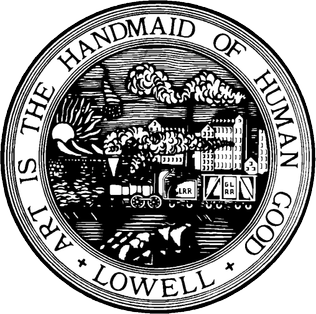
1846:
- The population of Lowell is 29,127.
- The Lowell and Lawrence Railroad.
1847:
- The Lowell Mill Girls donate clothing to the victims of the Irish famine.
- The city of Lowell raises $1990 for Irish famine relief.
- The Appleton Bank is incorporated.
- On Thanksgiving, the Northern Canal is completed.
1848:
- The Salem and Lowell Railroad is incorporated.
- On September 18, Abraham Lincoln visits Lowell.
1849:
- The Battle of Suffolk Bridge takes place.
- The Lynde Hill Reservoir is constructed by Locks And Canals Company in Belvidere .
1850:
- County Court House is erected.
1851:
- Centraville is annexed to Lowell.
1853:
- Belvidere Woolen Company is established.
- A strike at the Lowell Machine Shop.
- Huntington Hall is built.
- Wamesit bank is incorporated.
1854:
- Merchants Bank is incorporated.
1856:
- The Lowell jail is built.
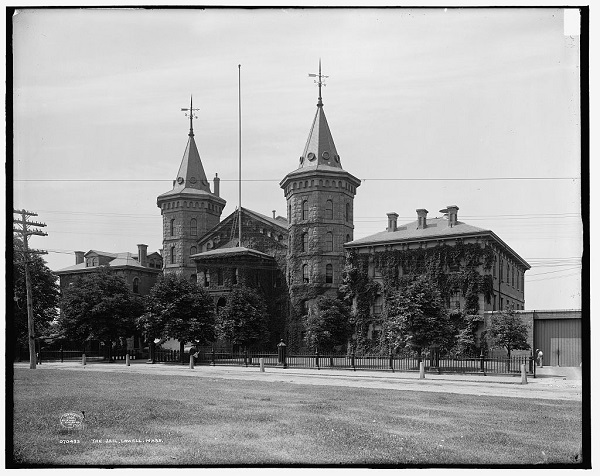
- The Daily Citizen newspaper is published.
1860:
- The population of Lowell is 36,827.
- On March 30, Rhoda M. Wilkins dies of poison and Anna A. Dower is later charged with her murder.
- On June 19, Elizabeth A. Moore is murdered by Bryant Moore.
1861:
- The textile mills in Lowell sell off the remainder of their cotton supply and close down production.
- On April 19, the Sixth Massachusetts Volunteer Infantry Regiment attempt to stop the Baltimore Riot. in Maryland and several soldiers are killed including two from Lowell, Luther Ladd and Addison Whitney. These soldiers are the first casualties of the Civil War.
- On April 20, the Soldier’s Aid Association formed, the first in the U.S.
- On September 24, Prince Jerome Napoleon and Princess Clotilde visit Lowell.
- On July 16, Nathan Appelton dies.
1863:
- The Lowell Horse Railroad is incorporated.
- On February 25, the Soldier’s Fair takes place.
1864:
- The First National Bank is established.
- On March 1, the Lowell Horse Railroad line opens.
1865:
- On June 17, a monument to Ladd and Whitney is dedicated.
1866:
- The Music Hall opens.
1867:
- St. John’s Hospital is founded.
- On July 4, the Statue of Victory is erected in Monument Square.
- The Old Ladies Home is established.
- On October 8, General Sheridan visits Lowell.
1868:
- St. Joseph’s Church is established to serve the growing French-Canadian community.
- Lowell holds its first celebration of St. Jean-Baptiste Day at St. Joseph’s Church.
- Cowley’s History of Lowell is published.
- Memorial Day is observed in Lowell for the first time.
- On December 4, General Ulysses S. Grant visits Lowell.
- In December, the Old Residents’ Historical Association is established.
1869:
- The Lowell Hosiery Company is incorporated.
1870:
- The United States Cartridge Company opens.
1871:
- A smallpox epidemic leads to the death of 178 Lowell residents.
- The Central Savings Bank is organized.
- The Fire Alarm Telegraph is established.
- The Framingham Railroad is established.
- On December 9, the Grand Duke Alexis of Russia visits Lowell.
1872:
- The People’s Club is established.
- The Pawtucket Bridge is completed.
- The Water Works is established.
1873:
- The Lowell Morning Times is established.
- The Young Women’s Home is established.
1874:
- The first French-Canadian to be elected to public office in Lowell, Samuel P. Marin, is elected to the City Council.
- A fire at Wamesit Mills causes $40,000 worth of damage.
- The Grand Army of the Republic Hall is dedicated.
- The Pawtucketville and Middlesex Village are annexed to Lowell.
- The Kitson Machine Company is incorporated.
- The Lowell and Andover Railroad opens.
1875:
- The Knights of Pythias dedicate their new hall.
- King Kalakaua visits Lowell.
1876:
- The First Portuguese boardinghouse in Lowell opens.
- Lowell holds its semi-centennial celebration.
- On June 8, Brazilian Emperor Dom Pedro visits Lowell.
- The Reform Club is established.
1877:
- The French Congregational Church is founded.
- The Shaw Stocking Company is formed.
- The J. C. Ayer Company is incorporated.
1878:
- The Lowell Sun newspaper is established.
- The Lowell Art Association formed.
- The First annual regatta of Vesper Boat Club is held.
- The Lowell District Telephone Company is formed.
- Charles Cowley’s History of the County of Middlesex published in the Middlesex County Manual.
1879:
- The Morning Mail newspaper is established.
- Dr. Moses Greeley Parker invents telephone numbers in Lowell.
- The United States Cord Company is established.
1880:
- United Cartridge Company recruits Swedish workers.
- The first Greek and Polish immigrants arrive in Lowell.
- Charles Stuart Parnell visits Lowell.
- Fire breaks out at Chase and Faulkner’s Mills.
- Armenians began settling in Lowell.
- The population of Lowell is 59,485.
1881:
- St. Jean Baptiste procession organized in response to growing anti-French-Canadian sentiment in Lowell.
- J. H. Guillet establishes the L’Abeille, the first Franco-American daily newspaper in the United States.
- The Electric Light Company is formed.
- The American Bolt Company is incorporated.
1882:
- The first Irish mayor of Lowell, John J. Donovan, is elected.
- On August 5, Central Bridge burns down.
- The Citizens Newspaper Company is incorporated.
1883:
- The St. Joseph’s School opens in Lowell, which is the first Franco-American school in the diocese.
- Erie Telephone Company formed in Lowell.
- The City Council vote to make City Library free, and to open a free reading room.
- The Aiken Street and Central bridges are finished.
- The New England Telephone and Telegraph Company is organized.
1884:
- The Pickering Knitting Company is established.
1885:
- The Naturalization Club is founded.
- Swedish Evangelical Lutheran Church is constructed on Meadowcraft Street.
- The Lowell Day Nursery is established.
- The Taylor Street Bridge is completed
1886:
- The first issue of L’Etoile, a French-Canadian newspaper, is printed.
- On April 1, Lowell celebrates its semi – centennial of its incorporation as a city.
- Lowell Co-operative Association is organized.
1887:
- St. Jean Baptiste Church is founded.
- L’Union St. Joseph builds headquarters at 266 Dutton Street.
- Whittier Cotton Mills are incorporated.
- Pilling Shoe Company is established.
- Middlesex Safe Deposit and Trust Company is incorporated.
- The Lowell and Dracut Street Railway Company is chartered.
1888:
- The J. H. Guillet, Lowell’s first Franco-American lawyer, is admitted to bar.
- The Criterion Knitting Company is incorporated.
1889:
- The New Opera House opens.
- On July 17, the Horse Railroad Stable burns with 117 horses and 31 cars inside.
- On August 15, President Benjamin Harrison visits Lowell.
- Thorndike Manufacturing Company is organized.
1890:
- The Lowell Board of Trade is established.
- The corner stones of new City Hall and Memorial Hall are laid.
- An armory is built on Westford Street.
- The Dracut Strike takes place.
- The Lowell Trust Company is organized.
- The Public Market and Packing Company is incorporated.
- The First Russian Jews arrive in Lowell.
- Typhoid epidemics break out in Lowell.
1891:
- The Lowell General Hospital is established.
- Greek immigrants begin working in the Lowell textile mills.
- The Massachusetts Mohair Plush Company is incorporated.
- A Grand reception for three Civil War generals, Nathaniel P. Banks, Daniel Sickles, and Benjamin Butler, is held.
- The cornerstone of the Odd Fellows Building is laid.
- The Post Office on the corner Appleton & Gorham is constructed.
1892:
- The Swedish Methodist Church is established.
- The Highland Club House is built.
- On January 11, General Benjamin Butler dies and his body lies in state at Huntington Hall before being buried at Hildreth Cemetery.
- The Saint Joseph’s Roman Catholic College for Boys is constructed on Merrimack Street.
1893:
- On June 3, Memorial Hall is dedicated.
- A French-Canadian High School for boys is established.
- On October 14, the New Lowell City Hall is dedicated.
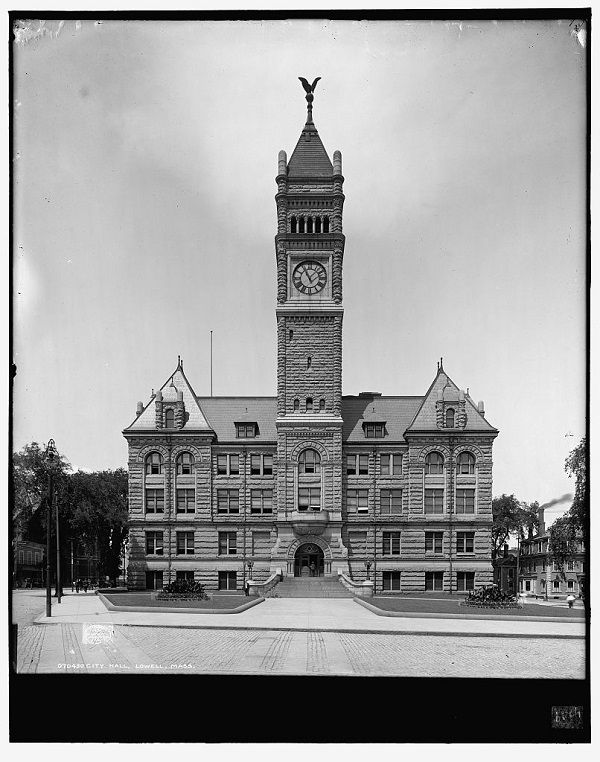
- The Electric Trolley System in Lowell is established.
- The Consumers’ Brewing Company is incorporated.
- The Moody School is dedicated on Rogers Street.
- The Associate Building is completed.
- The Merrimack Croquet Company, Courier-Citizen Company and Fifield Tool Company is incorporated.
- The L’Union Franco-Americaine is established.
- The Courier-Citizen Corporation is founded.
1894:
- Lowell State Teacher’s College is established.
- The Lowell chapter of the Daughters of American Revolution is established.
- The Middlesex Women’s Club is established.
- The Vesper Country Club is established.
1895:
- The Lowell Technical Institute is established.
1896:
- The Merrimack Woolen Mills Company is incorporated.
- The new Lawrence Street Railroad bridge is completed.
- The Grace Universalist Church is dedicated on Princeton Boulevard.
- On March 2, the Merrimack River floods.
1897:
- The State Normal School is completed.
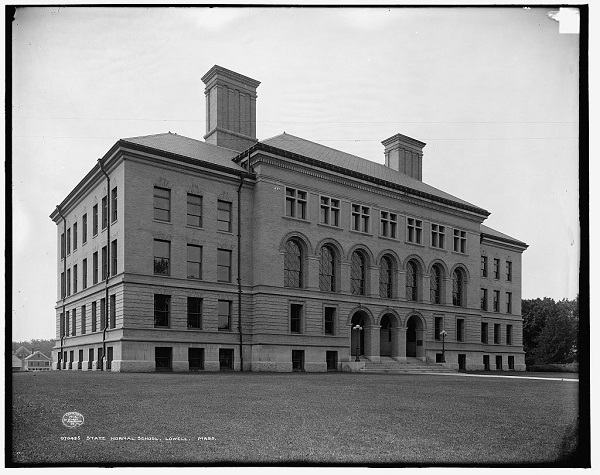
- In January, the Lowell Textile School opens.
- The Moody Street Bridge and new County Court House are completed.
1899:
- The Lowell Manufacturing Company is sold to Bigelow Carpet Company.
- The O’Sullivan Rubber Company is established.
- The Sons of Montefiore Synagogue is constructed on Howard Street.
1900:
- A tuberculosis epidemic breaks out in Lowell.

1901:
- St. Casimir’s Church is constructed on Church Street.
1902:
- The Anshe Sfard Synagogue is constructed on Howard Street.
- The Ohabe Shalom Shul (“Litrac Shul”) is established by Lithuanian Jews at 63 Howard Street.
- In May of 1902, the Lowell Historical Society is established.
1903:
- The Lowell textile mills lock its workers out in anticipation of a strike.
- A Typhoid epidemic breaks out in Lowell.
1904:
- The Holy Trinity Polish Roman Catholic Church is established.
- The St. Louis de France parish is established in Centralville.
1905:
- The Boott Mills is reorganized.
- Lowell Chapter of the Polish Falcons is formed.
1907:
- The St. Stanislaus School is established.
1908:
- St. Anthony’s church is constructed on Central Street.
- The Greek Holy Trinity Church is constructed on Lewis Street.
- The Notre Dame de Lourdes parish and grammar school is established in Highlands.
- The Franco-American orphanage is established.
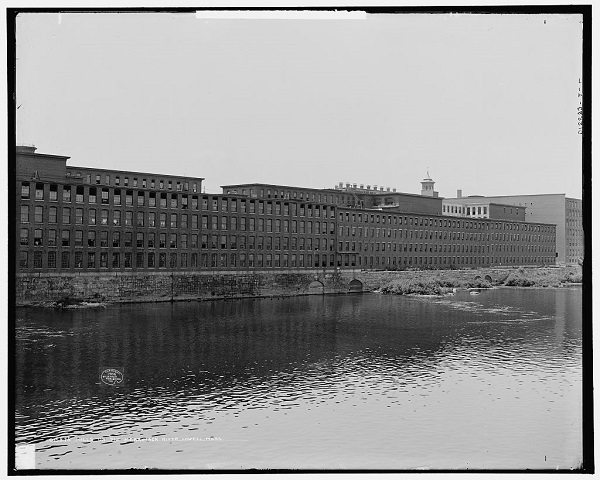
1910:
- The Dom Polski (Polish National Home) Club is established.
1912:
- The A. A. Johnson & Co. cigarette factory opens.
- On April 29, former President Theodore Roosevelt and President Taft visit Lowell.
1916:
- The Bigelow Carpet Company leaves Lowell.
1918:
- The Middlesex Company ceases production.
- The Spanish Flu epidemic reaches Lowell.
1919:
- The St. George’s Antiochian Orthodox Church is established.
1920:
- Local and Federal agents arrest various Lowell residents are arrested in Lowell during the Red Scare
- Eamon de Valera visits Lowell.
1922:
- On March 12, Jack Kerouac is born in Lowell.
- In September, the Lowell Memorial Auditorium is dedicated.
1923:
- The Transfiguration Church is established.
- The St. Jeanne D’Arc Church is established in Pawtucketville.
- The Laganas Shoe Manufacturing Company opens on Market Street.
1926:
- The Suffolk Mills is sold.
- The Lawrence Manufacturing Company is sold.
- The Hamilton Manufacturing Company ceases production.
1927:
- Temple Beth-El is established.
- Temple Beth-El purchases The Highlands Club and establishes a congregation in the upper Highlands.
- The Appleton Manufacturing Company relocates to the South.
- The Massachusetts Mills is sold and ceases production.
- The Tremont Mills ceases production.
1928:
- The Greek Holy Trinity Church is occupied by dissidents and a fight breaks out on the church steps.
- The Saco-Lowell Shops ends production in Lowell.
1930:
- St. Joseph’s Hospital is established.
1931:
- St. Marie’s Parish in South Lowell is established.
1933:
- After prohibition is repealed, the Harvard Brewery resumes brewing beer.
- Workers at the Laganas Shoe Company go on strike.
1935:
- The electric street cars in Lowell are taken out of serve.
1936:
- The Great Flood of 1936 takes place.
- The city of Lowell celebrates its centennial.
1940:
- The population of Lowell is 101,389.
- New wave of Greek immigrants flock to Lowell due to war in Greece.
1941:
- Louis Vergados leads a strike at the Boott and Merrimack Mills.
1946:
- Prince macaroni begins production in Lowell.
1950:
- The population of Lowell is 97,249.
- Jack Kerouac’s novel Town and the City is published.
- The Wannalancit Textile Company moves into the former Suffolk Mills.
1951:
- On October 16, President Harry Truman has a whistle stop speech at The Depot.
- On October 21, Dwight Eisenhower has whistle stop speech at The Depot.
1956:
- The Boott Mills close.
1957:
- Joan Fabrics purchases its first factory in Lowell.
1958:
- Merrimack Manufacturing Company ceases production.
1960:
- The population of Lowell is 92,107.
- The Merrimack Mills is demolished.
- The Merrimack Valley Textile Museum is established.
1963:
- On August 30, actor Michael Chiklis is born in Lowell.
1964:
- Ellen A. Sampson becomes the first woman Mayor.
1965:
- On October 4, professional boxer Micky Ward is born in Lowell.
1970:
- The population of Lowell is 94,280.
1974:
- Lowell Heritage State Park is established.
1975:
- University of Lowell is established.
- Vietnamese immigrants arrive in Lowell.
- The population of Lowell is 91,177.
1976:
- The Lowell Historical Society publishes Cotton was King, the first general history of Lowell in over fifty years.
1978:
- The Lowell National Historical Park was established.
1979:
- Cambodian and Laotian immigrants arrive in Lowell.
- Benjamin Butler’s mansion at 333 Andover street is demolished.
1980:
- The population of Lowell is 92,418.
1981:
- The Wannalancit Mills close.
1982:
- The Lowell National Historical Park Visitor Center opens.
1985:
- The first annual literary festival “Lowell Celebrates Kerouac” is held in Lowell.
- Lowell’s first Buddhist temple is founded.
- The Grace Shoe Company, last major shoe factory in Lowell, closes.
1986:
- The New England Quilt Museum is established.
1987:
- Major fire in the old Lawrence Manufacturing Company Mill.
1988:
- The Jack Kerouac Commemorative is dedicated on Bridge Street.
1989:
- A fire breaks out in the Lawrence Manufacturing Company buildings.
1991:
- The University of Massachusetts’ Lowell campus is established.
1992:
- The Boott Cotton Mills Museum opens.
1996:
- St. Peter’s Church on Appleton Street is torn down.
1997:
- The American Textile History Museum opens in Lowell.
1998:
- President William Clinton visits Lowell to attend a fundraiser.
2000:
- The population of Lowell is 105,167.
2001:
- Former President George W. Bush visits Lowell for MCC Celebrity Forum.
2008:
- The movie Invention of Lying is filmed in Lowell.
2009:
- The movie The Fighter portraying Lowell native Micky Ward is filmed in Lowell.
2010:
- The population of Lowell is 106,519.
2013:
- The Richard P. Howe Bridge on University Avenue is completed.
2015:
- Cambodian Refugee Monument is installed at Lowell City Hall.
2016:
- The American Textile Museum closes.
Sources:
Cowley, Charles. History of Lowell. Boston: Lee & Shepard, 1868.
“Timeline.” Lowell Historical Society, lowellhistoricalsociety.org/Timeline
“An Industrial History of Lowell, Massachusetts for secondary schools.” Open BU, Boston University Libraries, open.bu.edu/handle/2144/8105

Hi, I happened to go to Lowell, with my camera in hand of course. I always found a photo opportunity. I came across and old factory type building with the building name on the outside. Unfortunately name is somewhat faded. I was looking through your article, to see if I could catch a glimpse of some of the old factory type buidlings, and piece together what letters I have of name I can read. the first word I can only make out “d..e..o.. c..” The second word the only letters I can try to make out are “I.. s.. c.. ” ANy idea. I would send a picture but I do not see an option. I am just curious.